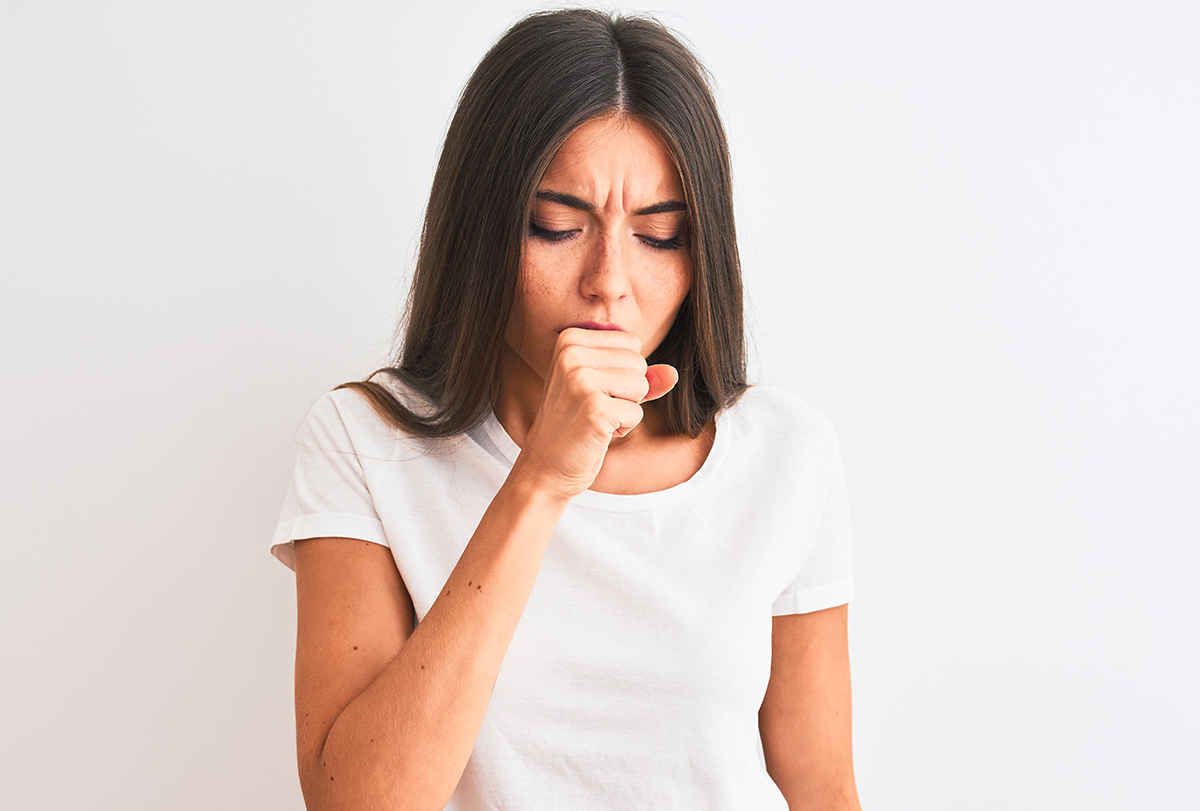In this article:
Mucus is a sticky gel-like substance that is produced throughout the body by mucous membranes called the mucosa.

These membranes mostly line the cavities and passages that connect your internal system with the outside environment, such as the nose, mouth, and eyes as well as the respiratory, gastrointestinal, reproductive, and urogenital tracts.
Phlegm refers to the relatively thick mucus secreted by the respiratory tract in excessive amounts, which ends up clogging the airways. There are two sources of phlegm:
- Specialized epithelial cells called goblet cells found in the tissue lining the surface of the airways
- Submucosal glands present in the connective tissue beneath the mucosa
Components of Phlegm
Phlegm, also referred to as sputum, is essentially composed of water, inorganic salts, heavily glycosylated proteins (proteins attached with carbohydrates), dead white blood cells, enzymes, and other cells.
How Common Is This Problem?
The excessive production of mucus and phlegm in the respiratory tract over a prolonged period is the starting point of chronic obstructive pulmonary disease (COPD).
COPD affects more than 200 million people globally and is likely to become the third leading cause of mortality in the world by 2030, according to the WHO estimates. (1)
Nearly 10% of the entire adult population of the world suffers from chronic wet cough. (2) Even in children, it is the second most common symptom of respiratory disease, next only to runny nose. (3)
The Phlegm Color Spectrum
Mucus is naturally colorless and runny, but it usually becomes thick and discolored during an infection or some other health problem. The dense mucus coughed up from the lungs is known as phlegm or sputum.
Phlegm can be of different colors depending upon the underlying issue:
1. Yellow-green phlegm
Yellow-green phlegm is suggestive of an infection. Your body directs an increased number of white blood cells to the respiratory tract to fight the infection, some of which contain a green-colored protein that discolors the mucus.
The greater the number of these cells, the greener your phlegm will be.
2. Pink, red, or bloody phlegm
Pink, red, or bloody phlegm is, usually, the result of excessive, forceful, or prolonged coughing fits that exert a lot of pressure on your lungs and can rupture small blood vessels.
In such a case, the blood can seep out of the vessel and mix with the mucus to give it pink or red streaks. However, pink, especially frothy, phlegm can also indicate increased pressure in the lung vessels associated with congestive heart failure (CHF).
3. White phlegm
White phlegm is produced during allergies, asthma, and viral infections.
4. Brown phlegm
Brown phlegm may be observed in smokers and patients who have cystic fibrosis or bronchiectasis. However, bloody sputum, especially when caused by infection, can look brownish.
5. Charcoal-grey or blackish phlegm
Charcoal-grey or blackish phlegm, also known as melanoptysis, is common in chain smokers and certain pathologies such as coal workers’ pneumoconiosis (anthracosis). (4)
Causes

The following factors can trigger the production of phlegm:
1. Indoor thermoregulation
Indoor thermoregulation (heating or air conditioning) can suck the moisture from your surrounding environment.
Breathing in arid air for prolonged periods can dry out your airways, which reduces the effectiveness of the cilia, which are tiny hair-like projections that line the respiratory passages and propel the movement of mucus. This leads to the buildup of phlegm in the respiratory tract.
2. Dehydration
Dehydration can activate histamine in the airways, which often leads to an overproduction of mucus in the respiratory tract. This mucus often becomes condensed and sticky, thereby forming phlegm.
3. Smoking
Smoking can irritate the respiratory lining in the nose and the lungs and trigger the excessive secretion of mucus and phlegm. (5) In fact, people who smoke frequently are prone to chronic mucus hypersecretion (CMH), also called chronic bronchitis. (5)
4. Allergies
Allergies can lead to a runny and stuffy nose, itching, and sneezing due to blockage or congestion.
The nose normally produces mucus, which traps substances, including dust, pollen, pollution, and germs such as bacteria and viruses. Mucus flows from the front of the nose and drains down the back of the throat, causing phlegm.
5. Respiratory infections
Respiratory infections, such as the common cold, influenza, pneumonia, bronchitis, pharyngitis, and sinusitis, can cause inflammation in the airways and lungs, which induces phlegm secretion.
Once the microbe enters the respiratory tract, the body triggers mucus production in the airways to keep the infection-causing bacteria or virus from advancing further. Phlegm formation is, therefore, a natural immune response of the body to fight respiratory infections.
6. Lung diseases
Lung diseases, such as COPD, chronic bronchitis, cystic fibrosis, tuberculosis (TB), pneumonia, are all characterized by excessive phlegm production.
7. Dietary habits
Dietary habits can also influence phlegm production. Diets with a high fiber content from fruits have been associated with less production of phlegm. (6)
8. Acid reflux
Acid reflux is the backflow of acidic stomach contents into the food pipe, which not only irritates your throat but often results in breathing problems such as a cough, hoarseness, noisy breathing, or asthma, causing thickening of mucus.
9. A weak or diseased heart
A weak or diseased heart can cause fluid retention in the lungs, which in turn triggers cough, shortness of breath, and phlegm formation.
Symptoms
Coughing is your body’s natural way of eliminating excess mucus or phlegm accumulated in the airways. Thus, a persistent wet cough is one of the most definitive signs of phlegm buildup in your throat and chest.
Besides coughing, phlegm formation is usually accompanied by the following symptoms:
- Labored breathing
- Feeling run down or tired without any physical exertion
- Sore throat
- Wheezing, or a whistling sound while you breathe
- Hemoptysis, or coughing up blood or bloody mucus
- Respiratory infection
- Chest pain due to increased effort to breathe
Medications to Reduce Phlegm

A variety of drugs can help relieve phlegm buildup in the respiratory tract. These are the most commonly used ones:
1. Expectorants
Expectorants help dilute the consistency of phlegm, making it easier to cough out. Guaifenesin is the most trusted expectorant agent that has been found safe and effective in reducing phlegm production triggered by acute upper respiratory tract infections and stable chronic bronchitis. (7)
Despite the widespread use of this expectorant, there are still no well-controlled clinical trials to conclusively establish its efficacy. (8)
2. Decongestants
Decongestants help clear nasal congestion or a stuffy nose by reducing inflammation in the nasal passageways and mucus production.
They are available over the counter in the form of pills, syrups, and sprays, and you can take whichever one would suit you best. However, people with hypertension must check with their doctor before taking decongestants.
3. Antihistamines
Antihistamines are prescribed if your phlegm is the result of an allergic reaction. These drugs curb the inflammatory response in the body by blocking the production of histamines. As a result, the swelling in the nasal tissues goes down, and so does the production of phlegm.
4. Mucolytics
Mucolytics are aerosol medications that are administered through inhalation. Once in your respiratory system, they thin out the mucus accumulated in your airways and facilitate its easy expulsion. (9)
Note: Always read and follow the instructions given on the label of the medicine. Even if you are using OTC drugs, it is best that you consult your doctor about the appropriate dosage.
Diagnosis
Phlegm production can occur due to a variety of underlying reasons, which may require different treatments. Thus, identifying the root cause is important to determine the best course of treatment for your particular case.
The doctor may order the following tests to arrive at a conclusive diagnosis:
- Chest X-ray to check for pneumonia and other such conditions
- CT scan to rule out bronchiectasis
- Lung function tests, which measure how much and how fast the patient inhales and exhales air, to help diagnose asthma and other conditions
- Sputum test to detect TB, wherein a sample of coughed-up phlegm is tested in the lab for the presence of suspected strains of bacteria
- Echocardiogram, which uses high-frequency sound waves (ultrasound) to assess for possible congestive heart failure in the appropriate clinical context
When to See a Doctor

The presence of phlegm can require urgent medical help in the following cases:
- If you experience severe shortness of breath or difficulty breathing
- If you develop hives or swelling in the face or throat, which makes it difficult for you to swallow
- If you notice swelling in the legs or a cough that worsens when you lie down, as it can be a sign of heart failure, especially in people with preexisting cardiovascular issues
- If you experience unexplained weight loss or night sweats, which could be a sign of TB
- If the patient is an infant younger than 3 months
- If the cough persists for more than 10–14 days
- If you cough up blood
- If you develop a fever, which may indicate an underlying bacterial infection that requires antibiotics
- If you start producing a high-pitched sound called stridor while inhaling
- If you cough up thick, odorous, yellowish-green phlegm, which could be symptomatic of a bacterial infection
- If you frequently suffer from violent and rapid coughing spells
Final Word
Coughing up phlegm is a common occurrence that can result from a wide range of conditions, but it is most typically due to respiratory infections. The color of the secretion can vary depending on the underlying cause, which can range from mild to serious and acute to chronic.
Addressing the root cause of the problem while keeping your body hydrated is the only way to reduce the buildup of mucus inside your respiratory tract.

- Was this article helpful?
- YES, THANKS!NOT REALLY


